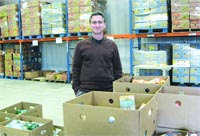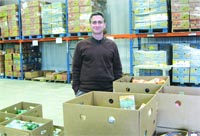
Checks and Balances
A Time of Challenge and Uncertainty for Nonprofits

Food Bank Director Andrew Morehouse says demand for help is soaring, while all the constituencies that support his organization are feeling the sting of a down economy.
Downturns in the economy present challenges and anxiety for most nonprofit agencies; just as demand for many services from food to fuel assistance to cultural distractions is rising, donations are declining. Administrators with such agencies say this is a time to be creative, in terms of both fund-raising efforts and initiatives to show people that they can contribute in ways other than writing a check.
Nonprofit agencies provide food for the body, mind, and spirit, together making up more than 7.6% of our total economy. But during a recession, they face a financial catch-22: while demand for goods and services in other sectors is slowing, the need for nonprofit services continues going up often way up just as funding becomes tighter.
With states imposing draconian budget cuts, stocks continuing to swoop, rise, and fall like kites in a strong wind, and individuals reviewing their personal finances bill by bill, BusinessWest asked nonprofit directors and staff how they expect the economy to impact their own numbers. Several of the organizations we spoke with had just embarked on their year-end fund-raising drives. And while what the final numbers will show is anyones guess, each is facing, head on, the challenge of raising money in an historically difficult time.
Joel Weiss, president and CEO of the United Way of the Pioneer Valley, says he suspected that the organizations 2008 fall campaign might be a tough one. Last year the United Way raised $7 million, and matching or exceeding that number will be a daunting task.
Even before the last four to six weeks I had a gnawing feeling that this would be the campaign where we saw the effect of the struggling economy, said Weiss, noting that the United Ways workplace campaigns provide 90% of the organizations annual funds.
Weiss says that while his organization will be raising funds for several more weeks, thus far the campaigns, both nationally and locally, are getting mixed reviews. Weve had some donations that are up, weve had some that are down. Weve done some face-to-face leadership solicitations, and some are up, some are staying the same, and some are down a little. So its hard to know what the overall impact is going to be.
To increase the donor base, the United Way is putting a greater emphasis on cultivating individuals in the community, said Weiss. Two years ago we identified about 1,800 people and small, home-based businesses that have never contributed to the United Way. We cant get to all 1,800, obviously, but if we can get to 100 or more a year and make a case for support, then we can build a base of new contributors.
Nonprofits, Weiss said, always need to be thinking about new strategies even in good times because theyre competing for funding from a small, relatively homogenous pool of donors. Its not an unhealthy competition, he said, its just a fact of life. All nonprofits need to be able to distinguish themselves from each other in order to raise money now. In times like these we work harder, we work smarter, we work longer hours than we might otherwise, and we have to be much more creative.
Springfield Museums Director Joseph Carvalho agreed.
He said that, while he has confidence in the economy bouncing back, his challenge is making sure Springfields cultural gems are sustained through any coming difficulties. A new Museum of Springfield History is under construction, and though its only $1 million away from the $7.5 million needed for completion, Carvalho suspects that this balance will be difficult to raise.
It takes a lot of communication with partners who know the Springfield Museums are essential to the life of downtown and the region, and that were one of the ingredients that makes Springfield special, he said, referring both to the campaign for the history museum and fund-raising for his organization in general.
In this issue, BusinessWest looks at the plight of nonprofit agencies during an economic slowdown, and how administrators approach the additional challenges they are now facing.
Dollars and Sense
Attendance at libraries and museums actually tends to go up during troubled economic times, said Carvalho, who went on to explain why. These are places where people can be with other people, public spaces where they dont feel so isolated, and where they can leave the threat of economic difficulties behind in a safe, fun, educational, peaceful environment.
Visits to the museums are actually up 18% from last year, but the jury is still out, Carvalho says, on the effects of the recession; the organizations fiscal year doesnt end until June 30.
Any institution that depends upon trusts and endowments with investments in the stock market is going to be facing a challenge next year, if not sooner, he said. And the issue is compounded for nonprofits like museums that also depend on visitation. I cant imagine that it wont have an impact, but to what extent remains to be seen.
Carvalhos comments hint at just some of the myriad ways in which nonprofits are impacted by a soft economy. Often, donations trend downward just as demand for whatever service is being provided is rising.
Such is the case at the Food Bank of Western Massachusetts.
Andrew Morehouse, the facilitys executive director, said the demand on food providers was up 17% in just the first six months of the year, and that was before the repercussions on the real economy, the productive economy. We collect our information from the 400 front-line food providers we make food available to, and it takes a while to collect that information. We should have numbers through September shortly.
Last year, the Food Bank distributed almost 6.4 million pounds of food or five million meals to shelters, food pantries, child-care programs, and others who provide emergency food to the community. Those numbers are certain to rise for this year amid great uncertainty over funding from a variety of courses.
Approximately one-quarter of the Food Banks $8 million operating budget comes from state and federal sources, another 25% from businesses and corporations, 25% from miscellaneous sources, and the remaining 25% from individuals and all of those constituencies are being challenged by the economic downturn.
The Food Banks fall fund-raising campaign is just beginning, and theres a lot of uncertainty and a lot of stress around it, said Morehouse. But folks in my line of business, while it may be more accentuated now, this is what we deal with day in, day out, year to year.
The big uncertainty is how the current economic climate will immediately affect fund-raising from individual donors, and were bracing to see what the answer is, he continued. Theres no crystal ball out there; Im hoping that at the very least well be able to sustain the level of individual donations that weve gotten in the past, but the need has increased. Thats why we need to be always reaching out to the community and raising this issue and offset any decline that we may see.
Food for Thought
As currently structured, Morehouse said, the emergency food system is reaching its limits.
For the first time the Food Bank is hiring an advocacy and education coordinator. The goal is not only to boost community awareness and giving, but to encourage people to act to change public policy at the local, state, and federal levels.
Increasingly, Morehouse said, and I cant emphasize this enough, were turning to new solutions like food stamps and other policy changes that have a tremendous impact and build new solutions that go beyond food banking.
Food stamps, he pointed out, not only help people who temporarily cant put food on their table, but act as an economic stimulus; the money gets spent in the local economy, leaving those individuals more money to spend also locally on other necessities they could otherwise not afford, all of which stimulates further economic growth.
Large and well-endowed organizations, such as the Community Foundation of Western Massachusetts, are relatively immune to the economys ill heath. With $122 million in total assets from which to make grants, the foundation isnt prey to the daily concerns of smaller nonprofits. As President Kent Faerber said, the gifts we get are typically larger, or there are estates in the works. Because were a long-term asset administrator, our fortunes dont go up or down quite as readily as some nonprofits.
Nancy Reiche, vice president of programs for the foundation, says the impact of the economic crisis is likely to show up for the organization in the next application cycle.
The grants that were evaluating this cycle came into us in August, before the big hits happened. I think when we see the applications that come in January, our next deadline, were probably going to see fewer new programs being developed, and people looking to pare back to what they can do well, trying to maintain programs that are already working.
Reiche says the foundation may also see organizations joining forces, whether through creative collaborations or financial mergers. This past year, for example, Kamp for Kids united with the Carson Center for Human Services, and Child and Family Services joined the Center for Human Development.
Overall, she said, I think people are definitely a bit more somber. Theyre hoping that things get better, but know that it may be a little while before they do.
Support Systems
Adding to the current economic woes, said the United Ways Weiss, is the diminishing support for non-profits from the federal and state governments, forcing those agencies to increasingly rely on private donations. The result has been donor fatigue. The way to address this issue, he said, is focusing in on donor intent, trying to find a synergy between a donors interests and the need of the community.
Kathy LeMay, president and founder of Raising Change, agrees. LeMay works with both donors and non-profits to cultivate a culture of generosity and inspire social change. She said donors are being more careful with their check-writing than they would when times are better, but theyre also finding different ways to make contributions.
I think the question for donors has to be, whats the opportunity here? she explained. During the financial bubble, many of us could write checks like we never could before. That was the way we could support community nonprofits, so we capitalized on that opportunity. Now, with money more tight, theres a chance to have a new conversation with our nonprofit friends. This is when we figure out the resources that we have in addition to our financial ones our time and our talents.
When the money is easy, said LeMay, theres actually a downside for both donors and nonprofits. People who are busy making money write checks, but theyre not as involved or personally committed to those organizations as they otherwise might be.
Nonprofits need the gifts people have to give in addition to their checking accounts, she said. And donors need to see themselves as change agents. The thing about generosity is that it has an extraordinary impact on your day-to-day life.
I ask donors to ask themselves this question: what gets me up in the morning, and what keeps me up at night? Find the nonprofits that share your vision, and call them nonprofits are a place to go to for hope and renewal. Ask them, what can we create together, and how can I be a great ally and ambassador for you?
An active collaboration with a nonprofit also makes it easier, said LeMay, to write that check, even when money is more scarce. All of a sudden youre invested in something larger, and its for the greater good.





